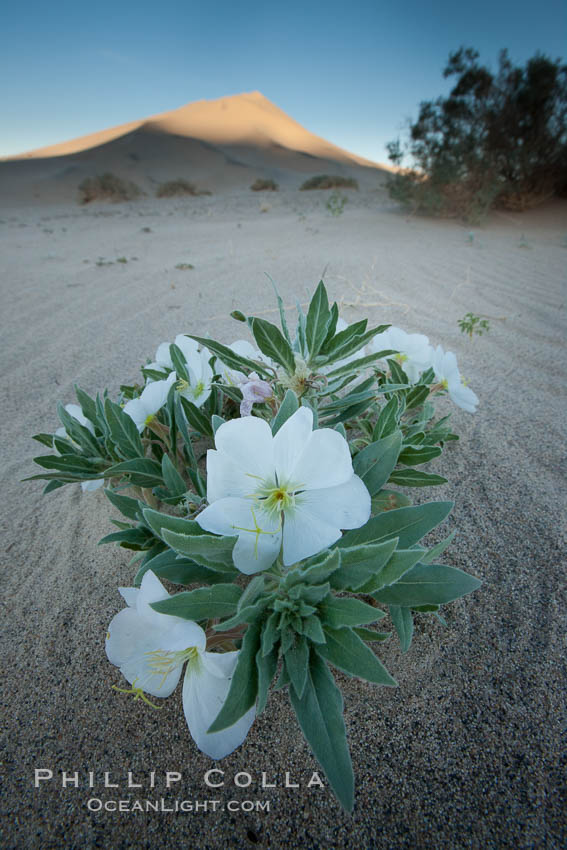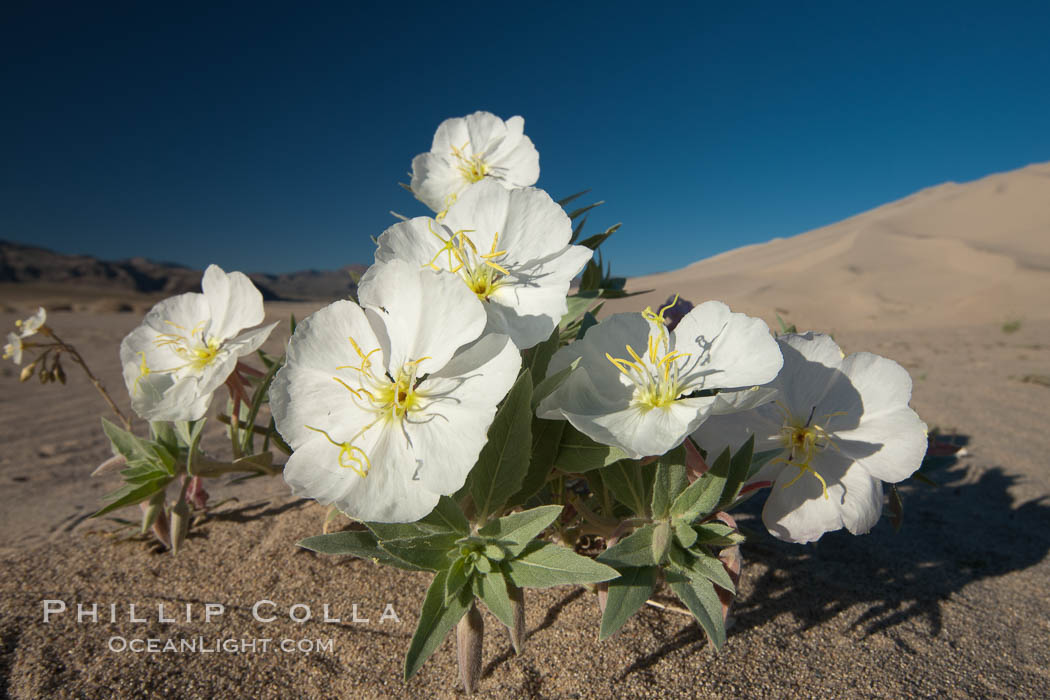Stock photos of the Eureka Valley Dune Evening Primrose, Oenothera californica eurekensis, in Death Valley National Park.
The Eureka Valley Evening Primrose (Oenothera californica eurekensis) is a federally endangered wildflower found only on and near the sand dune habitat of the Eureka Valley, in the far northern reaches of Death Valley National Park. Observed primarily at the Eureka Sand Dunes, it is also found on the nearby Saline Spur Dunes and Marble Canyon Dunes. According to a 2007 review of the 1982 recovery plan for the species, the Eureka Valley Evening Primrose is “a subspecies with a moderate degree of threat and a high recovery potential.” During spring and fall seasons that have enough rainfall, the plant blooms (typically April through June) with large white flowers that turn red as they age. As soon as I saw the first one, it instantly reminded me of its close cousin, the Dune Evening Primrose that I have seen in Anza Borrego. I am intrigued at how severely ecologically isolated the Eureka Valley Evening Primrose is, existing on just three sets of sand dunes. Sort of like a plant found on only a tiny atoll in the middle of the ocean, but this is the desert. Because of its rare nature and the wherethehellamI habitat in which it resides, it is now one of my favorite flowers.
Eureka Valley Dune Evening Primrose. A federally endangered plant, Oenothera californica eurekensis is a perennial herb that produces white flowers from April to June. These flowers turn red as they age. The Eureka Dunes evening-primrose is found only in the southern portion of Eureka Valley Sand Dunes system in Indigo County, California.
Image ID: 25237
Species: Eureka Valley Dune Evening Primrose, Oenothera californica eurekensis
Location: Eureka Dunes, Death Valley National Park, California, USA
Eureka Valley Dune Evening Primrose. A federally endangered plant, Oenothera californica eurekensis is a perennial herb that produces white flowers from April to June. These flowers turn red as they age. The Eureka Dunes evening-primrose is found only in the southern portion of Eureka Valley Sand Dunes system in Indigo County, California.
Image ID: 25267
Species: Eureka Valley Dune Evening Primrose, Oenothera californica eurekensis
Location: Eureka Dunes, Death Valley National Park, California, USA
I recently made a short visit to the Eureka Dunes with my photographer friends Garry McCarthy and John Moore. We were on a sort of banzai run**, trying to cover Eureka Dunes, the Racetrack and Badwater Salt Flats in 3 days. We definitely were not looking for wildflowers, so we were fortunate to find a few Eureka Valley Evening Primroses along the outskirts of the dunes. Our visit took place in mid-May, and heading into Death Valley I figured the wildflowers were past peak and would be burnt to a crisp by the harsh conditions. Indeed, in the lower regions of the park, wildflowers that presented such an excellent display earlier in the spring were long gone. However, the floor of the Eureka Valley is at an elevation of 2800′, where conditions are much cooler. In fact, as we approached Eureka Valley, and especially on the dirt roads between Eureka Valley and Death Valley at altitudes between 2000′ and 4000′, I was surprised by the richness and variety of the wildflower displays. It really was superb, and I might consider that region for a wildflower trip in future years since it offers a ton of solitude and some awesome vistas.
The Eureka Valley Sand Dunes are home to another endangered plant species: the Eureka Valley Dune Grass, Swallenia alexandrae.
**banzai photographer (n): (1) a photographer with a working spouse and multiple kids each of whom has lots of activities that require driving all over the place during the week, help with homework in the evenings, and then driving all over the place on the weekends; (2) a photographer who crams five days of photography into a single weekend; (3) a photographer with a banzai attitude about life; (4) a photographer who photographs banzai trees.





